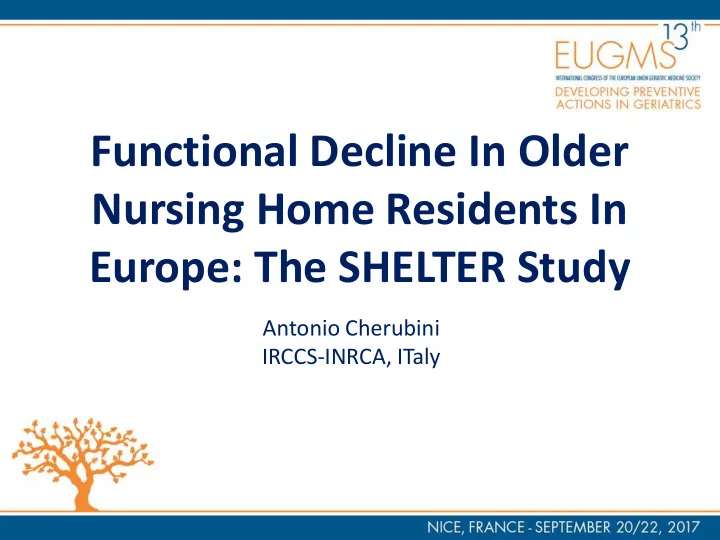

Functional Decline In Older Nursing Home Residents In Europe: The SHELTER Study Antonio Cherubini IRCCS-INRCA, ITaly
CONFLICT OF INTEREST DISCLOSURE I have no potential conflict of interest to report
Disability is an important outcome for older nursing home (NH) residents, closely linked to their quality of life and to higher health care costs.
M. Fedecostante et al. / JAMDA 17 (2016) 306-311
AIM OF THE STUDY: To identify independent predictors of functional decline in older NH residents, taking into account both resident and facility characteristics.
METHODS We evaluated 1760 older (> 65 years) NH residents participating in the SHELTER* study (57 NH in 8 countries) , followed up to 12 months. *funded by the EU FP7th CN:223115
METHODS Multi-item summary scales embedded in the interRAI LTCF were used to measure residents characteristics: Cognitive status was assessed using the 7-point MDS Cognitive Performance Scale (CPS). a score of 2 or higher is equivalent to a diagnosis of dementia with scores ranging from 0 (intact) to 6 (very severe impairment). The MDS Depression Rating Scale was used to assess the presence of depressive symptoms and a score ≥ 3 was used to diagnose depression. Polypharmacy was defined as the regular use of 5 or more drugs.
METHODS To evaluate functional status , the seven point MDS Activities of Daily Living (ADL) Hierarchy scale was used in the SHELTER study. However, in order to make results comparable with our previous findings in the ULISSE population we recoded the MDS Hierarchy scale in the ADL Long Form scale of the MDS. This scale is the most sensitive to change over time of the 3 principal summary MDS-ADL scales.
METHODS Each ADL item has 6 possible categories of response: the categories of response for each MDS-ADL self- performance item range from 0 (total independence) to 4 (total dependence). The MDS Long-Form ADL scale is a sum of the responses to all the 7 individual ADL items and has a score ranging from 0 to 28 . A decline in functional status has been defined as an increase of at least 1 point in the MDS Long-Form ADL scale during the follow-up.
METHODS The data were analyzed to test for significant differences between NH residents who have experienced or not ADL decline. Mixed-effects logistic regression model was used for taking into account the nested data structure arising from repeated measurements of patients within countries. For each observation, e.g. each episode of ADL decline, each patient and each nursing home a set of covariates was also recorded. Country effect was estimated as a random intercept; demographic, clinical, and organizational features variables were estimated as fixed effects.
RESULTS We analyzed the data of 1760 NH residents with 12 months follow-up. Age distribution was 84.5 ± 7.8 and 1331 (75,6%) were female. Distribution of NH Residents according to country Country N (%) Czech Republic 162 (9.2%) Germany 322 (18.3%) England 244 (13.9%) Finland 288 (16.4%) France 272 (15.5%) Israel 119 (6.8%) Italy 202 (11.5%) Netherlands 151 (8.6%) Total 1760 (100,0%)
RESULTS Residents without Residents with ADL Total sample ADL decline decline Variables (n=1760) p -value (n=869) (n=891) (% or median ± IQ) (% or median ± IQ) (% or median ± IQ) Age 84.8 (79.0-89.9) 85.2 (80.1-89.5) 85.0 (79.5-89.7) .053 Age>85 years 48.8 51.6 50.2 .234 Gender (Female) 74.5 76.8 75.6 .258 BMI 24.7 (21.1-28.5) 24.4 (21.5-27.9) 24.6 (21.4-28.1) .461 Cognitive status CPS (0-6) 2.0 (0-3) 2.0 (1-4) 2 (1-4) <.001 CPS 0-1 42.1 30.8 36.4 CPS 2-4 39.1 46.0 42.6 <.001 CPS 5-6 18.8 23.2 21.0 ADL 28 12 (3-18) 9 (4-15) 10 (4-17) .003 Polypharmacy 76.1 76.7 76.4 .770 (≥5 drugs) Multimorbidity 80.4 82.4 81.4 .274 (≥2 diseases)
RESULTS Multivariate analysis 95% C.I.for OR Variables B S.E. Sig. OR Lower Upper Age 0,007 0,007 0,305 1,007 0,994 1,020 Sex 0,090 0,119 0,448 1,095 0,867 1,382 CPS 2-4 (ref CPS 0-1) 0,676 0,124 <0,001 1,965 1,542 2,504 CPS 5-6 (ref CPS 0-1) 0,892 0,160 <0,001 2,440 1,785 3,337 Baseline ADL 28 -0,064 0,009 <0,001 0,938 0,922 0,954 Urinary incontinence 0,467 0,129 <0,001 1,596 1,239 2,055 Geriatrician -0,412 0,140 0,003 0,662 0,503 0,872 Nurse available during night -0,711 0,297 0,016 0,491 0,275 0,878
CONCLUSIONS Disability is probably the most important outcome for nursing home residents and besides resident characteristics also facility characteristics, e.g. the presence of a geriatrician, are relevant to influence functional decline.
Acknowledgment The SHELTER study was funded by the EU 7th Framework Programme under grant agreement FP7-HEALTH-2007-B 223115.
Recommend
More recommend